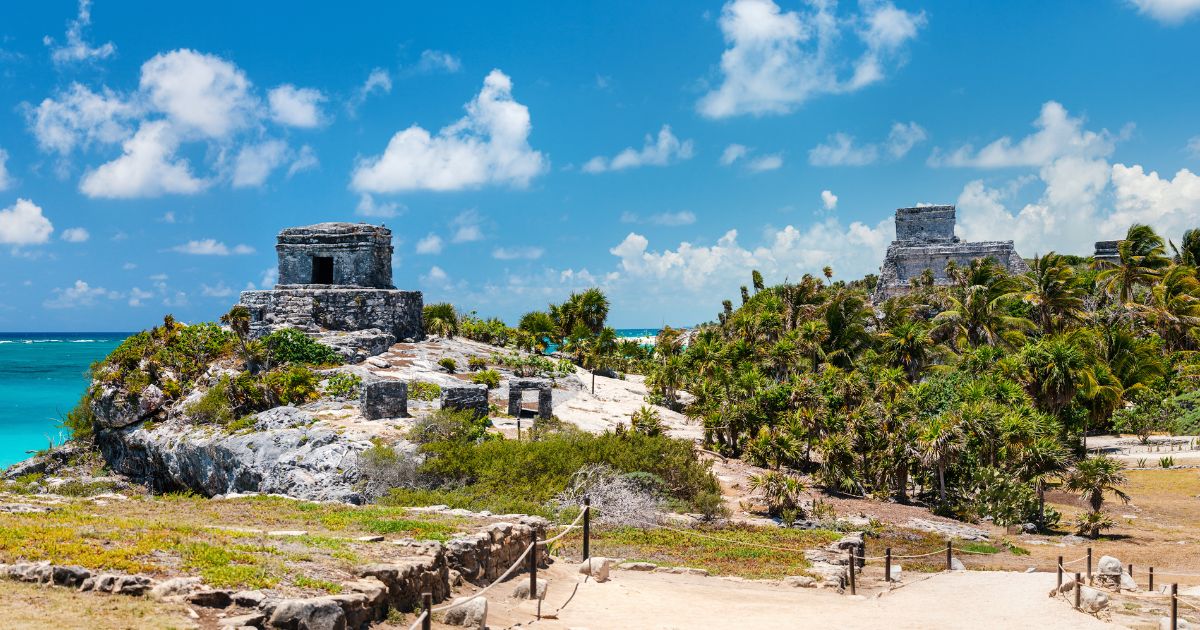
What is Tulum Jaguar Park?
Tulum Jaguar Park, a newly established protected area in Quintana Roo, is redefining sustainable travel in Mexico. Spanning approximately 6,200 acres (2,500 hectares), it serves as the second-largest nature reserve in the region. The park was created to protect both the natural and cultural heritage of the area. It includes forest trails, beaches, and the iconic Tulum Archaeological Zone, commonly referred to as the Tulum Ruins.
Why is Tulum Jaguar Park Special?
The mission of Tulum Jaguar Park is to promote slow, sustainable tourism rooted in environmental preservation and cultural respect. To achieve this, the park has implemented several strict measures. Cars are heavily restricted, plastics are banned, vendors have been removed, and visitor numbers are tightly controlled. These actions aim to create a peaceful environment for both people and wildlife, shifting Tulum’s identity from a party destination to an ecotourism hotspot.
Where is Tulum Jaguar Park Located?
Nestled between dense jungle and the turquoise Caribbean Sea, Tulum Jaguar Park offers a serene escape that blends ecological conservation with ancient Maya history. The park integrates Tulum National Park with the Jaguar Flora and Fauna Protection Area (APFFJ) to form one massive reserve. This reserve stretches from the coastal cliffs where the Tulum Archaeological Zone is located, extending deep into the jungle.
Where is the Entrance to Tulum Jaguar Park?
Tulum Jaguar Park has multiple access points, though most visitors enter through the main entrance. Other entrances include the South Entrance on Coba Avenue and a further south location requiring a reservation at a Tulum beach hotel or restaurant. These entrances accommodate various modes of transportation, including rental cars, bikes, colectivos, and the Tren Maya (Mayan Train).
What’s Inside Tulum Jaguar Park?
Visitors can enjoy a variety of attractions within Tulum Jaguar Park, such as:
- Tulum Archaeological Zone: The dramatic cliffside ruins overlook the Caribbean and reflect Tulum’s significance as a Maya maritime hub.
- Torre de Avistamiento: An observation tower offering amazing views from a circular, open-topped deck 32 feet above the ground.
- Museum: The Museo de la Costa Oriental (East Coast Museum) in the Visitor Center features displays on Mayan culture, regional artifacts, and immersive digital exhibits.
- Observation Points: Lookout towers and coastal viewpoints like the Tulum Lighthouse provide sweeping views of the jungle and sea, ideal for photography and nature observation.
- Beachfront Serenity: Quiet, protected beaches accessible only to ticket holders offer a rare calm not found on many Mexican beaches.
- Forest & Reforested Trails: Winding paths through second-growth jungle and re-wilded lands allow visitors to spot local wildlife such as coatis, toucans, jaguarundis, and iguanas.
Note: Everything except the Tulum Ruins is included in the entrance price. The ruins require an additional fee.
How Much is the Tulum Jaguar Park Admission?
Admission involves multiple fees, which are usually paid separately:
- General Admission: Foreign visitors pay 295 MXN (about $15 USD), while Mexican nationals and Quintana Roo residents pay less with a valid ID.
- CONANP Fee: Varies between 60-120 MXN (about $3.50-$6.50 USD).
- INAH Fee: 100 MXN per person (about $5 USD) for entry to the Tulum Ruins.
Total cost for admission to Tulum Jaguar Park and the Tulum Ruins is approximately 515 MXN ($28 USD). Children under 12 are free.
Do I Need to Pay to Get in Tulum Jaguar Park to Access Tulum Ruins?
Yes — access to the Tulum Ruins is now fully integrated within the Jaguar Park system. Visitors must first pay to access the park (295 MXN pesos), then pay a separate fee at the ruins (100 MXN pesos). At the main entrance, there is also the CONANP fee for Mexico’s protected areas commission, which ranges between 60-120 MXN pesos.
Which Tulum Beaches Can I Access Inside Tulum Jaguar Park?
Several pristine beaches are within the park’s boundaries, including Playa Pescadores and Playa Santa Fe. These require a Jaguar Park entry ticket. A FREE electric shuttle runs from the Tulum Ruins to these beach access points and other parts of the park. Other beaches within the park include Playa Mangle, Playa Maya, Tulum Ruins Beach, and Mirador Beach.
Is There Parking at Tulum Jaguar Park?
Yes, but parking is limited and has restrictions. The main entrance near the Tren Maya station offers free parking, though spots fill up quickly on weekends and peak times. The Avenida Coba entrance has a paid parking lot. Vehicles entering from the hotel zone must have a reservation at a Tulum beach club or restaurant inside the park.
What’s Prohibited in Tulum Jaguar Park?
To maintain conservation and preserve the visitor experience, the park enforces several restrictions:
- No plastic, including single-use bottles and bags.
- No commercial vendors (unless grandfathered in).
- No cars (unless guests have reservations at on-site facilities).
- No drones, no smoking, no alcohol, and no climbing ruins.
FAQs About Tulum Jaguar Park
- Hours: Open daily from 7am-7pm, with the last entrance at 5pm.
- Shuttle: A FREE electric shuttle is available within the park.
- Biking: Yes, it’s about a 20-35 minute ride from downtown Tulum.
- Museum: The Museo de la Costa Oriental is included in the park ticket.
- Multiple Fees: While the current system is complex, similar systems exist in other Mexican sites like Chichen Itza.
- Wildlife: Visitors may see coatis, iguanas, and other jungle species, though jaguars are rarely seen.
- Beaches: Yes, you can walk to some beaches if staying at a beachfront hotel outside the park.
Final Thoughts on Visiting Tulum Jaguar Park
Tulum Jaguar Park represents a bold transformation in Riviera Maya tourism, blending ecology, culture, and sustainable travel. With its lush trails, archaeological wonders, quiet beaches, and thoughtful infrastructure, it invites visitors to connect deeply with Mexico’s natural and historical legacy. Whether by bike, train, rental car, or foot, entering the park is more than a visit — it's a journey toward mindful exploration.
